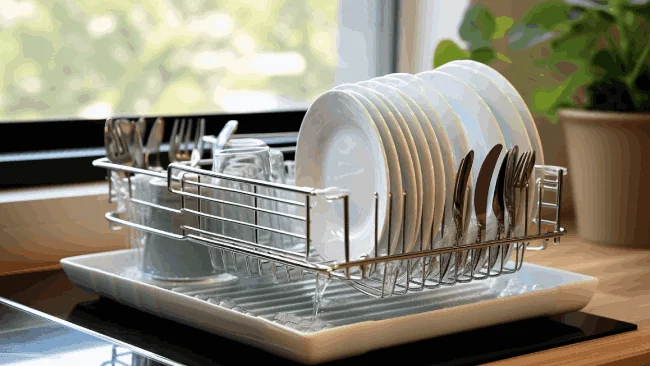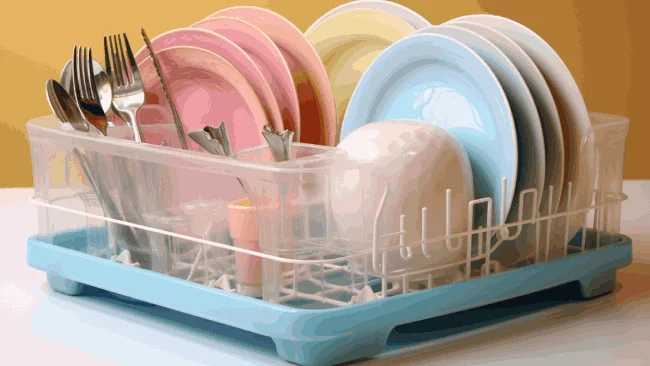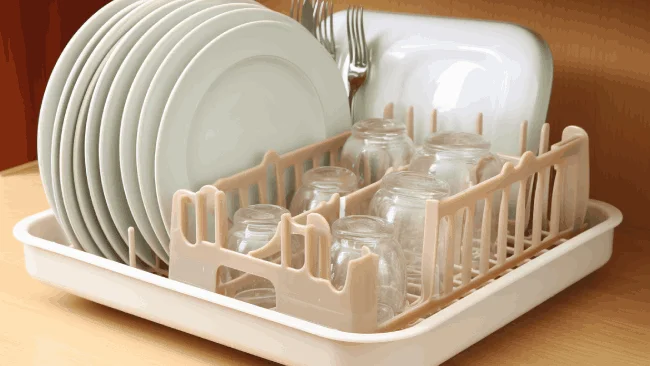Maintaining a clean and hygienic dish drainer is paramount for a healthy kitchen environment. Whether your dish drainer is made of plastic, stainless steel, or another material, regular cleaning ensures its longevity and prevents mold, bacteria, and unpleasant odors.
To maintain your plastic dish drainer rack, regular cleaning with dish soap and warm water is essential to remove surface dirt and grime. For deeper cleaning, you can make a vinegar solution and soak the rack to eliminate stubborn stains.
If stains are still left, a baking soda paste can be used. Don’t forget to disinfect the rack occasionally with a bleach solution.
Here, we will discuss five methods to keep your plastic constructed dish drainer rack clean and in top condition. You will also find if steam cleaning dish racks is a good idea and how often you should clean them.
Jump to Section
How Do You Keep a Plastic Dish Drainer Rack Clean: 5 Methods to Follow
Plastic-based dish-drying rack cleaning methods are not complicated, and you don’t have to spend much time on them. A few minutes each day is all it takes to keep your dish rack looking brand new.

Here are our five recommended methods to follow for maintaining a clean dish drying rack made from plastic:
No 1. Regular Cleaning with Dish Soap and Warm Water
For a consistently clean dish drying rack made of plastic, start by disassembling the rack if possible to ensure a thorough cleaning. Fill a sink or basin with warm water and add a few drops of dish soap.
Immerse individual components of the rack, such as trays and utensil holders, and take a soft brush or sponge to scrub away any food residue or soap scum.
Take special care to clean crevices and corners where debris may accumulate. Rinse each part thoroughly with clean water and let them air dry completely before reassembling the dish rack.
No 2. Vinegar Solution for Deeper Cleaning
Cleaning your plastic dish drainer rack with vinegar periodically will keep it fresh and hygienic. To do this, mix equal parts white vinegar and water in a basin or sink.
Take apart the rack and soak the components in the vinegar solution for about 15 to 30 minutes. The acidity of the vinegar helps break down mineral deposits and disinfect the rack.
After soaking, use a brush or sponge to scrub the parts, paying extra attention to stubborn stains. Rinse everything thoroughly with water and let the pieces air dry completely before reassembling the rack.
This vinegar solution provides a deeper clean, eliminating any lingering odors or stains and keeping your dish drainer rack made from plastic in top condition.
No 3. Baking Soda Paste for Stubborn Stains
Revitalize your plastic collapsible dish rack by tackling stubborn stains with a baking soda paste.
Mix baking soda and water until a thick paste is formed. Let the paste sit on the stained areas for 15 to 20 minutes. The mild abrasive nature of baking soda helps lift and remove stubborn stains without causing any damage to the plastic surface.
Use a soft brush or toothbrush to gently scrub the stained areas, paying extra attention to the tougher stains. Rinse the dish drainer with water thoroughly to remove baking soda residue. Finally, allow all the components to dry completely before assembling the dish rack again.
No 4. Disinfect with a Bleach Solution

To disinfect your plastic dish drainer rack, you can use a bleach solution. In a bucket of water, mix one tablespoon of bleach with one cup of water. Remove the dish rack and soak it in the liquid for 5 to 10 minutes.
Make sure to have proper ventilation during this process. After soaking, rinse the rack thoroughly with water to remove any residue. Let it air dry completely before putting it back into use.
Disinfecting with a bleach solution helps eliminate bacteria and other germs that may be present on the dish rack, ensuring a clean and safe environment for your dishes. We always recommend to follow safety precautions when handling bleach and avoid mixing it with other cleaning agents.
No 5. Ensuring Proper Ventilation to Prevent Mold Growth
Whichever method you choose to clean your dish rack, without proper ventilation, you may end up with a bigger problem on your hands: mold growth. Mold thrives in damp and dark environments, making the dish rack the perfect breeding ground if not properly dried.
To prevent mold, allowing air to circulate freely around the rack is important. Place the kitchen dish rack in a well-ventilated area and avoid enclosed spaces. Regularly inspect the nooks and crannies of the rack for any signs of mold. Clean the affected areas with white vinegar and water if you notice any mold.
FAQ’s: How Do You Keep a Plastic Dish Drainer Rack Clean
Can I use a steam cleaner on a plastic dish drainer?
While steam cleaners are effective for cleaning, they may not be suitable for use on plastic dish drainers due to the potential for heat damage or deformation. Excessive heat from a steam cleaner can cause the plastic to warp or melt, rendering the kitchen dish drainer ineffective.
We advise sticking to manual cleaning methods for plastic dish drainers. Simply use warm water and a mild detergent to clean your dish drainer. You can scrub the plastic surfaces gently with a sponge or brush to eliminate any stains or residue. Make sure you rinse it well and let it air dry prior to using it again.
Can I put my plastic dish rack in the dishwasher?
To maintain the cleanliness of your plastic dish rack, you may wonder if it’s safe to put it in the dishwasher. If you have a metal or heat-resistant plastic dish rack, it’s safe to toss it in the dishwasher.
The dishwasher’s hot water and detergent will effectively clean and sanitize the rack, removing any dirt, grime, or bacteria that may have accumulated.
Then again, you should note that not all plastic dish racks are dishwasher safe. Before placing it in the dishwasher, check the manufacturer’s instructions or label on the rack.
Is plastic or metal better for a dish rack?
Metal dish racks, particularly those made of stainless steel, are known for their sturdiness and durability. They can withstand heavy loads and are less likely to break or warp over time. However, metal racks may rust if not properly cared for, so it’s important to dry them thoroughly after each use.
In contrast, plastic dish racks are lightweight, easy to clean, and don’t rust. They’re also typically more affordable and come in various colors and designs. The choice between plastic and metal dish racks depends on your needs and aesthetic preferences.
How often should I replace my plastic dish drainer?
According to kitchen experts, consider replacing your plastic dish drainer if you notice cracks, discoloration, or difficulty cleaning it.

The lifespan of a plastic dish drainer depends on usage and maintenance. With regular use and proper care, a plastic dish drainer can last anywhere from one to three years. Still, if you notice any of the signs above of wear, it’s advisable to replace it sooner rather than later.
Conclusion
As you can see, to keep your plastic dish drainer rack clean, you should regularly rinse it with warm soapy water and scrub away any food particles or residue.
Also, you can soak it in a mixture of vinegar and water to remove any stubborn stains or odors. Don’t forget to dry it thoroughly after cleaning to prevent the growth of mold or bacteria.
Plastic is not as durable as other materials, so paying attention to any signs of wear and replacing your dish drainer when necessary is essential. So, keeping your plastic-based dish drainer rack clean and hygienic for longer in your kitchen is easy by following the tips and guidelines we shared above.





